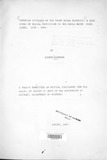| dc.description.abstract | This case study reconstructs the history of European settlers in Trans Nzoia district from 1920 to 1946. Chapter one serves as an introduction, outlining the historical problem under study and providing a survey of the literature relating to European settlement in Kenya. A summary,.of the methodological approach adopted during research con cludes the chapter.
Chapter two traces the origins of European settlement in the highlands. The early policies adopted by colonial officials to encourage white immigration are discussed. Close co-operation between the Government and settler leaders before
1914 is stressed as one important reason for the rapid imposition of European dominance during this period. Initiatives implemented by civil servants in the East Africa Protectorate often preempted intervention from Whitehall, the 1904 and 1911 evictions of Maasai from land designated for white
settlement being a case in point. Closer settlement was viewed by European colonists as a vital prere quisite for the consolidation of racial supremacy. The question of which settlers could best augment
the small white population was, therefore, subjected to close scrutiny. Following the outbreak of War in 1914, the matter was placed in abeyance,but in 1919 a settlement scheme for demobilised soldiers
had been approved by the Imperial Government. Under this scheme, many surveyed farms in Trans Nzoia were occupied and, subsequently, a predominantly soldier settler community emerged.
The settlers' political and economic interests are discussed in the third chapter, an assumption being that conditions in Trans Nzoia influenced their outlook. A controversial by-election for the Plateau North seat in 1921 underlined the fact that many local farmers were anxious about their future and wanted a Legislative Council representative who understood the problems confronting them. Moreover, the Trans Nzoia Farmers Association was dominated
by postwar settlers who aggressively pursued the objective of overseas marketing. Formation of the Plateau Grain Growers' Cooperative streamlined transportation arrangements and the absorption of this body into the Kenya Farmer Association in
1927 culminated in the centralisation of producer co-operatives. Meanwhile, construction of the Uasin Gishu railway and a branch line to Kitale had been completed.Developments within the district centred on the expansion of agricultural production. Following the collapse of flax prices, most settlers had concentrated on growing maize, with the result that monocrop farming was prevalent by the mid-1920s. Producer prices remained high and farmers continued to bring more land under cultivation, but the abrupt onset of economic depression in 1931 introduced a period of hardship. Chapter four is devoted to recounting major events affecting European farming in Trans Nzoia during the 1930s and early 1940s. As prices declined the acreage under crop contracted, with beleagured farmers resorting to Land Bank loans in order to remain on the land. The weaknesses of
monoculture were cruelly exposed and some preliminary attempts were made to diversify into mixed farming. Another problem, which predated the onset of the depression, was the chronic inefficiency of settler production in terms of an inability to utilise most of the land. One consequence had been a rapid increase in the population of African squatters and numbers of their livestock. Measures
taken to curb squatting were hampered by the reluctance of many settlers to remove a cheap source of resident labour and agricultural produce. The outbreak of war in 1939 resulted in younger farmers
being enlisted for active service and the introduction of a group farm management system. Over the next two years the Colonial Government implemented legislation meant to boost agricultural production in the highlands. Among the measures adopted were the introduction of guaranteed prices on specific scheduled crops and conscription of
African labour. During the war period,crop acreages in Trans Nzoia expanded rapidly and mobilisation of labour conscripts reduced the previous reliance on squatters. In chapter five,the Africans living and working under European domination is described. The beginnings of the Squatter system are located in the ready availability of fertile land in a sparsely populated district. African settlement predated the Europeans' arrival, with white settlers often
finding farms allocated to them occupied by African families. As conditions in neighbouring reserves changed because of social and economic dislocation, more families entered the district, finding short
periods of labour a small sacrifice in return for access to abundant land. Squatters formed the backbone of the .labour force in Trans Nzoia for most of the period under review. Attempts to control the population involved the imposition of livestock restrictions and more oppressive working requirements. Over the years~life became more difficult for many squatters and by 1946 when Trans Nzoia District Council had begun implementing measures aimed at eliminating the practice, the squatters' position had markedly deteriorated. The significance of a predominantly young male migrant wage labour force which increased over the years is also considered. The argument is that white settlers in the district were a farming community whose activities are of considerable significance in relation to the colonial period of Kenya's history. Social, political and economic implications of European predominance in Trans Nzoia, therefore, constitute an interesting subject of study | en |

